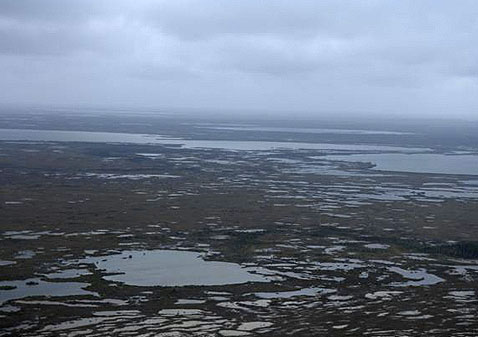Flight Log: Churchill CYYQ -- Iqaluit CYFB 06.09.2007
Date (local): 06.09.2007
Distance: 850 NM
scheduled Flying time: 6h 00min
Filed Route: DCT YQ BR10 YZS RR4 YFY DCT
ATIS Churchill: not available
Clearance: as FLP
Take Off Time (UTC): 13:38
Take Off Time (local): 08:38
ATIS Iqaluit: not available Weather :Time 2000Z Wind 050/14 to 24kts vis 6m sc 011 bro 033 Heavy Rain temp 4/2 QNH 29,29
Landing Time (UTC): 20:44
Landing Time (local): 16:44
 06.09.2007 Churchill/Iqaluit:
Such a storm ranged in Churchill during the night that we feared we would not be able continue on our flight, or that it would be very complicated at the very least. Towards morning the wind abated somewhat and we were even up in the air 20 minutes ahead of schedule.
06.09.2007 Churchill/Iqaluit:
Such a storm ranged in Churchill during the night that we feared we would not be able continue on our flight, or that it would be very complicated at the very least. Towards morning the wind abated somewhat and we were even up in the air 20 minutes ahead of schedule.
After taking off, we looked down at all the pools of water round the airfield and then left the inhospitable tundra.
We flew through the low blanket of cloud at about 30 km per hour wind speed. Up here it was sunny. The more we got closer to Hudson Bay, the more the weather cleared. However, a pretty constant wind persisted that was at least 20 kn at high altitude and at 3,500 m decreased to 10 kn.
After we reached our altitude, the air traffic controller asked us if we'd like to take a shortcut – I'd just wondered about this too. Now we could actually fly directly to Iqaluit and save about 80 nautical miles. Ideal with this headwind.
During the flight we were presented with the same picture: sheep-like cloud over Hudson Bay, below us not single ship, no movement, just huge waves with vast foamy crests on the water. This led us to conclude that the wind below was stronger than up in the sky. After about three hours, we flew past a large sandbank, located at the entrance to Hudson Bay. It looked like the north German island of Sylt – it was just located on the North Pole and a lot larger. It seemed to consist of sand masses pushed together by glaciers. The distinctive dunes on one side of the island showed just how strong the wind was there.
Half an hour later the landscape was completely different: a rocky island that had neither a beach nor any vegetation.
We started to leave Hudson Bay. According to weather reports, we could expect bad weather in Iqaluit because of a low-pressure area. And the weather in the skies really did change abruptly. Suddenly visibility was zero and ice formed on the wings, so that the de-icer had to be switched on. This was about one half hours before landing in Iqaluit. We had zero visibility until we landed and spent 1,5 hours flying in the icy pea soup at minus 12 degrees centigrade.
About 100 km before Iqaluit, we were astonished that the air traffic controller welcomed us in French. This part of Canada belongs to the district of Québec, where, as is well-known, French and English are spoken. I radioed back with a 'bonjour'and tried to communicate with the air traffic controllers in English. This proved not to be very easy, but they clearly realised this themselves when a traffic controller who spoke good English took over.
He took us from our altitude of 3,700m, from this real pea-souper, down to about 1,000 m. We had to remain there for some time because a Lear jet in front of us wanted to land in Iqualuit too.
The rain and wind grew stronger and stronger, the lower we descended and the nearer we got to the airfield. The air traffic controller complied with my request for radar guidance to carry out an instrument flight on the approach to runway 35.
The latest meteorological data showed that the lowest level cloud was at about 300m and that strong rain and winds were prevailing from 110° at 14 to 24 kn during landing. During landing we approached runway 35, so that the strong crosswind was also combined with slight tailwind.
We could only see the runway a few minutes before touching down. Nevertheless Marie landed very well and taxied onto the extremely wet runway.
We carried out our usual tasks, refuelling Marie and making sure that she was tied up because of the weather conditions. The temperature was 4°C on the airfield, with an icy wind blowing. So you could be forgiven for believing that winter had already arrived in the north of Canada.
Our handling agent, an Inuit, was very friendly and helpful, showing us everything and helping us reach our hotel safely.
 Loading. Please wait...
Loading. Please wait...

















